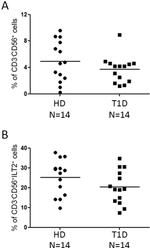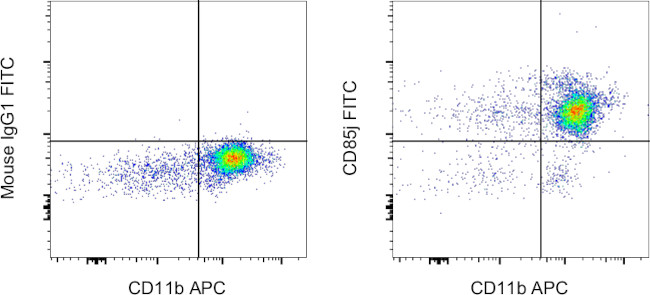Search Thermo Fisher Scientific
Invitrogen
CD85j (ILT2) Monoclonal Antibody (HP-F1), FITC, eBioscience™
FIGURE: 1 / 3
CD85j (ILT2) Antibody (11-5129-42) in Flow



Product Details
11-5129-42
Species Reactivity
Published species
Host/Isotype
Recommended Isotype Control
Class
Type
Clone
Conjugate
Excitation/Emission Max
Form
Concentration
Purification
Storage buffer
Contains
Storage conditions
Shipping conditions
RRID
Product Specific Information
Description: The monoclonal antibody HP-F1 recognizes CD85j, also known as ILT2, LILRB1, and LIR1. CD85j is a member of the ILT (immunoglobulin-like transcript)/LIR (leukocyte Ig-like receptor)/MIR (monocyte Ig-like receptor) family. CD85j is a single transmembrane glycoprotein with a long cytoplasmic domain containing 4 ITIMs which signal through interactions with SHP-1. Expression is found on myeloid cells (monocytes and dendritic cells) and some lymphoid cells including, subsets of NK, T and B cells. Expression has been correlated with leukemias such as ALL and CLL. Expression on CD8+ cells correlates with effector cell function and plays an important role in viral infections, including HIV, Ebstein Barr and CMV. The ligands for CD85j are MHC Class I molecules such as HLA-G, A, F, B27, E and F.
The monoclonal antibody HP-F1 has been shown to reduce the amount of CD16- dependent cytolytic activity of functional NK cells.
Applications Reported: This HP-F1 antibody has been reported for use in flow cytometric analysis.
Applications Tested: This HP-F1 antibody has been pre-diluted and tested by flow cytometric analysis of normal human peripheral blood cells. This may be used at 5 µL (0.25 µg) per test. A test is defined as the amount (µg) of antibody that will stain a cell sample in a final volume of 100 µL. Cell number should be determined empirically but can range from 10^5 to 10^8 cells/test.
Excitation: 488 nm; Emission: 520 nm; Laser: Blue Laser
Target Information
This gene is a member of the leukocyte immunoglobulin-like receptor (LIR) family, which is found in a gene cluster at chromosomal region 19q13.4. The encoded protein belongs to the subfamily B class of LIR receptors which contain two or four extracellular immunoglobulin domains, a transmembrane domain, and two to four cytoplasmic immunoreceptor tyrosine-based inhibitory motifs (ITIMs). The receptor is expressed on immune cells where it binds to MHC class I molecules on antigen-presenting cells and transduces a negative signal that inhibits stimulation of an immune response. It is thought to control inflammatory responses and cytotoxicity to help focus the immune response and limit autoreactivity. Multiple transcript variants encoding different isoforms have been found for this gene.
For Research Use Only. Not for use in diagnostic procedures. Not for resale without express authorization.
How to use the Panel Builder
Watch the video to learn how to use the Invitrogen Flow Cytometry Panel Builder to build your next flow cytometry panel in 5 easy steps.
Bioinformatics
Protein Aliases: CD85 antigen-like family member J; CD85j; Ig-like transcript 2; ILT-2; Immunoglobulin-like transcript 2; leucocyte Ig-like receptor B1; Leukocyte immunoglobulin-like receptor subfamily B member 1; leukocyte immunoglobulin-like receptor subfamily B member 1 soluble isoform; leukocyte immunoglobulin-like receptor, subfamily B (with TM and ITIM domains), member 1; LIR-1; MIR-7; Monocyte/macrophage immunoglobulin-like receptor 7; myeloid inhibitory receptor 7
Gene Aliases: CD85J; ILT-2; ILT2; LILRB1; LIR-1; LIR1; MIR-7; MIR7; PIR-B; PIRB
UniProt ID: (Human) Q8NHL6
Entrez Gene ID: (Human) 10859

Performance Guarantee
If an Invitrogen™ antibody doesn't perform as described on our website or datasheet,we'll replace the product at no cost to you, or provide you with a credit for a future purchase.*
Learn more
We're here to help
Get expert recommendations for common problems or connect directly with an on staff expert for technical assistance related to applications, equipment and general product use.
Contact tech support

